Exploring Political Culture: Women's Political Participation in Canada
VerifiedAdded on 2023/04/25
|8
|2364
|407
Case Study
AI Summary
This case study examines the political culture of Canada, focusing on the participation of women in politics, particularly in New Brunswick and Saskatchewan. It uses theories such as formative events, staples tradition, and fragment theory to explain regional political culture differences. The study reveals that Saskatchewan has a more receptive political environment for women compared to New Brunswick, influenced by factors like staple production (forestry vs. agriculture), immigration patterns, and the historical presence of social democratic parties. The research highlights how historical context, traditions, and regional economic activities shape political attitudes and opportunities for women's involvement in Canadian politics. Desklib offers a platform to explore similar solved assignments and past papers for students.
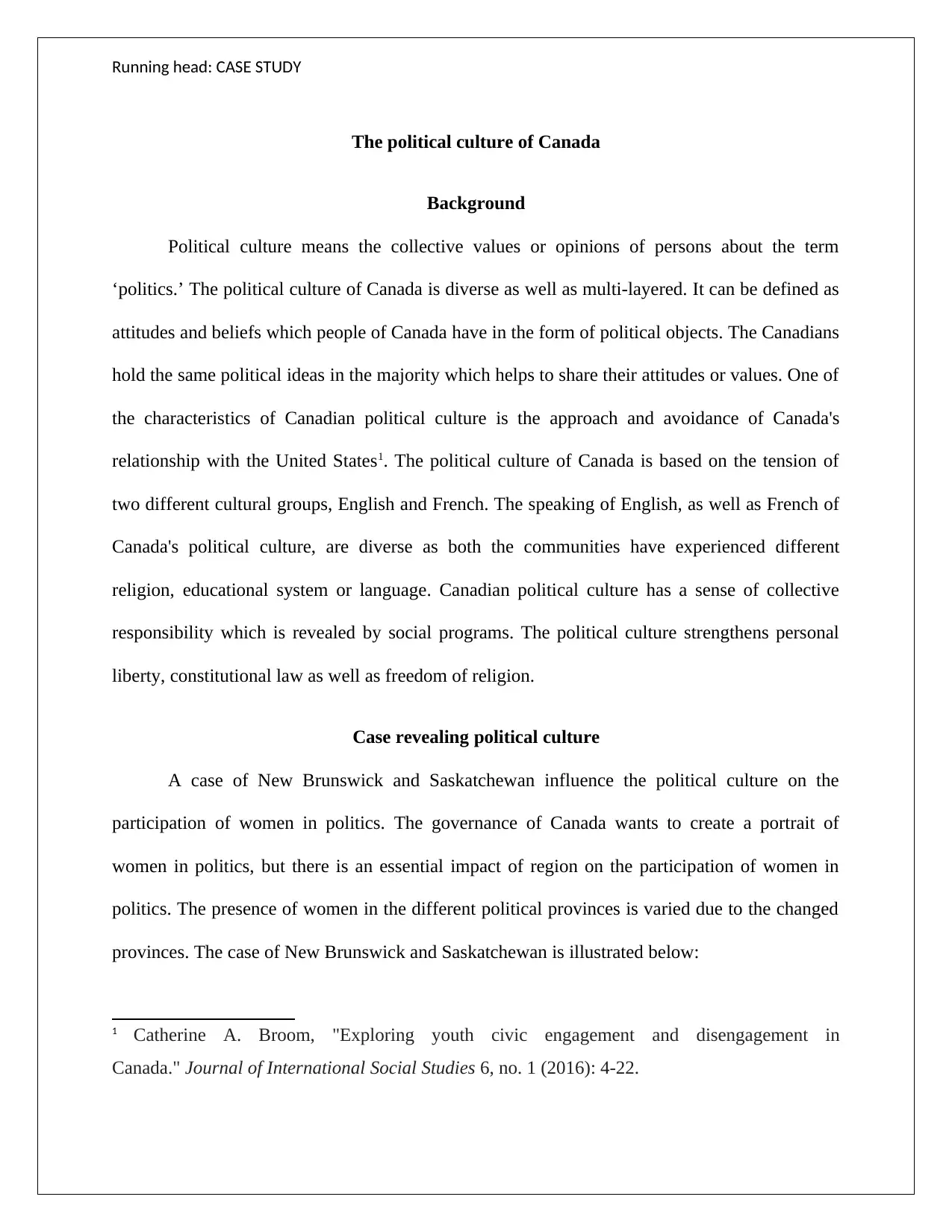
Running head: CASE STUDY
The political culture of Canada
Background
Political culture means the collective values or opinions of persons about the term
‘politics.’ The political culture of Canada is diverse as well as multi-layered. It can be defined as
attitudes and beliefs which people of Canada have in the form of political objects. The Canadians
hold the same political ideas in the majority which helps to share their attitudes or values. One of
the characteristics of Canadian political culture is the approach and avoidance of Canada's
relationship with the United States1. The political culture of Canada is based on the tension of
two different cultural groups, English and French. The speaking of English, as well as French of
Canada's political culture, are diverse as both the communities have experienced different
religion, educational system or language. Canadian political culture has a sense of collective
responsibility which is revealed by social programs. The political culture strengthens personal
liberty, constitutional law as well as freedom of religion.
Case revealing political culture
A case of New Brunswick and Saskatchewan influence the political culture on the
participation of women in politics. The governance of Canada wants to create a portrait of
women in politics, but there is an essential impact of region on the participation of women in
politics. The presence of women in the different political provinces is varied due to the changed
provinces. The case of New Brunswick and Saskatchewan is illustrated below:
1 Catherine A. Broom, "Exploring youth civic engagement and disengagement in
Canada." Journal of International Social Studies 6, no. 1 (2016): 4-22.
The political culture of Canada
Background
Political culture means the collective values or opinions of persons about the term
‘politics.’ The political culture of Canada is diverse as well as multi-layered. It can be defined as
attitudes and beliefs which people of Canada have in the form of political objects. The Canadians
hold the same political ideas in the majority which helps to share their attitudes or values. One of
the characteristics of Canadian political culture is the approach and avoidance of Canada's
relationship with the United States1. The political culture of Canada is based on the tension of
two different cultural groups, English and French. The speaking of English, as well as French of
Canada's political culture, are diverse as both the communities have experienced different
religion, educational system or language. Canadian political culture has a sense of collective
responsibility which is revealed by social programs. The political culture strengthens personal
liberty, constitutional law as well as freedom of religion.
Case revealing political culture
A case of New Brunswick and Saskatchewan influence the political culture on the
participation of women in politics. The governance of Canada wants to create a portrait of
women in politics, but there is an essential impact of region on the participation of women in
politics. The presence of women in the different political provinces is varied due to the changed
provinces. The case of New Brunswick and Saskatchewan is illustrated below:
1 Catherine A. Broom, "Exploring youth civic engagement and disengagement in
Canada." Journal of International Social Studies 6, no. 1 (2016): 4-22.
Paraphrase This Document
Need a fresh take? Get an instant paraphrase of this document with our AI Paraphraser
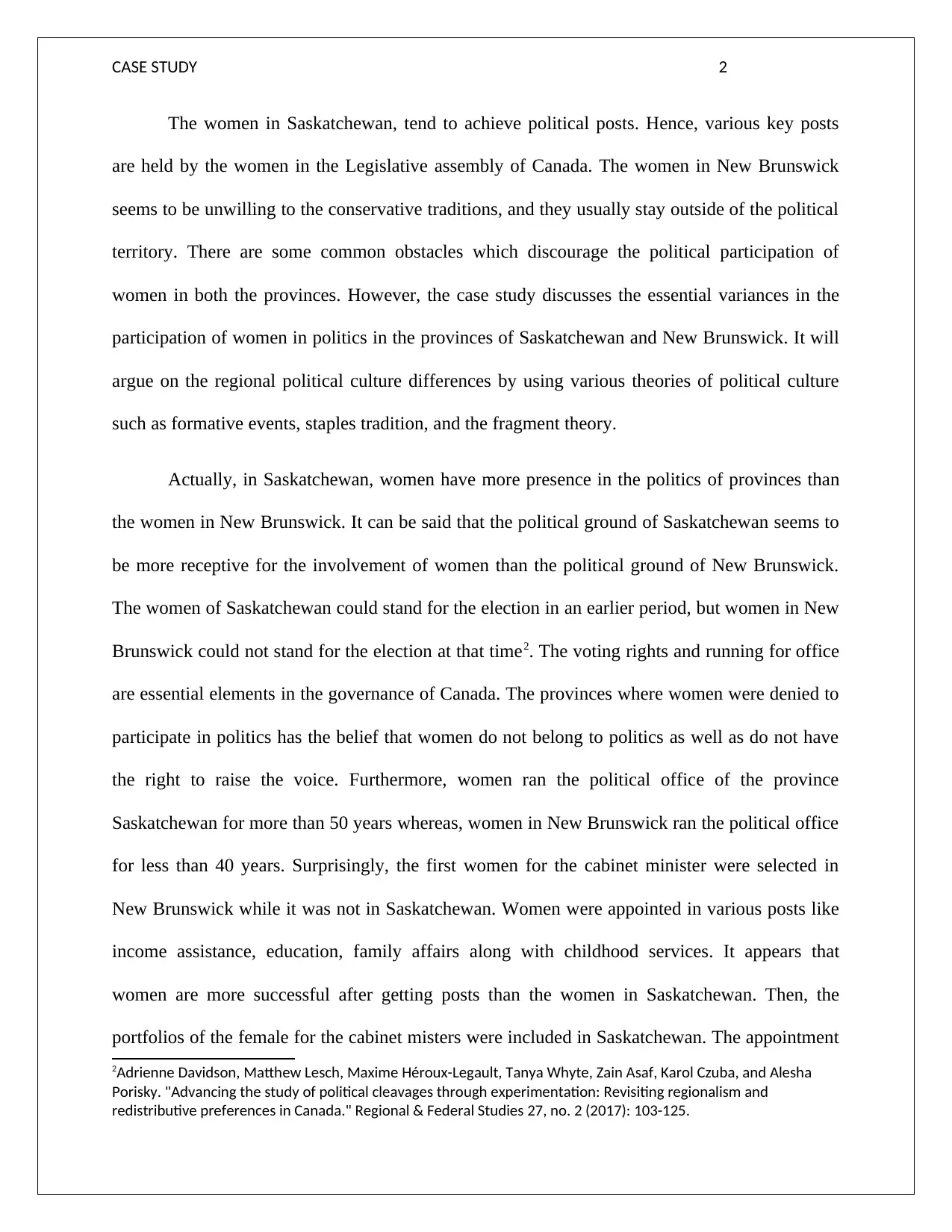
CASE STUDY 2
The women in Saskatchewan, tend to achieve political posts. Hence, various key posts
are held by the women in the Legislative assembly of Canada. The women in New Brunswick
seems to be unwilling to the conservative traditions, and they usually stay outside of the political
territory. There are some common obstacles which discourage the political participation of
women in both the provinces. However, the case study discusses the essential variances in the
participation of women in politics in the provinces of Saskatchewan and New Brunswick. It will
argue on the regional political culture differences by using various theories of political culture
such as formative events, staples tradition, and the fragment theory.
Actually, in Saskatchewan, women have more presence in the politics of provinces than
the women in New Brunswick. It can be said that the political ground of Saskatchewan seems to
be more receptive for the involvement of women than the political ground of New Brunswick.
The women of Saskatchewan could stand for the election in an earlier period, but women in New
Brunswick could not stand for the election at that time2. The voting rights and running for office
are essential elements in the governance of Canada. The provinces where women were denied to
participate in politics has the belief that women do not belong to politics as well as do not have
the right to raise the voice. Furthermore, women ran the political office of the province
Saskatchewan for more than 50 years whereas, women in New Brunswick ran the political office
for less than 40 years. Surprisingly, the first women for the cabinet minister were selected in
New Brunswick while it was not in Saskatchewan. Women were appointed in various posts like
income assistance, education, family affairs along with childhood services. It appears that
women are more successful after getting posts than the women in Saskatchewan. Then, the
portfolios of the female for the cabinet misters were included in Saskatchewan. The appointment
2Adrienne Davidson, Matthew Lesch, Maxime Héroux-Legault, Tanya Whyte, Zain Asaf, Karol Czuba, and Alesha
Porisky. "Advancing the study of political cleavages through experimentation: Revisiting regionalism and
redistributive preferences in Canada." Regional & Federal Studies 27, no. 2 (2017): 103-125.
The women in Saskatchewan, tend to achieve political posts. Hence, various key posts
are held by the women in the Legislative assembly of Canada. The women in New Brunswick
seems to be unwilling to the conservative traditions, and they usually stay outside of the political
territory. There are some common obstacles which discourage the political participation of
women in both the provinces. However, the case study discusses the essential variances in the
participation of women in politics in the provinces of Saskatchewan and New Brunswick. It will
argue on the regional political culture differences by using various theories of political culture
such as formative events, staples tradition, and the fragment theory.
Actually, in Saskatchewan, women have more presence in the politics of provinces than
the women in New Brunswick. It can be said that the political ground of Saskatchewan seems to
be more receptive for the involvement of women than the political ground of New Brunswick.
The women of Saskatchewan could stand for the election in an earlier period, but women in New
Brunswick could not stand for the election at that time2. The voting rights and running for office
are essential elements in the governance of Canada. The provinces where women were denied to
participate in politics has the belief that women do not belong to politics as well as do not have
the right to raise the voice. Furthermore, women ran the political office of the province
Saskatchewan for more than 50 years whereas, women in New Brunswick ran the political office
for less than 40 years. Surprisingly, the first women for the cabinet minister were selected in
New Brunswick while it was not in Saskatchewan. Women were appointed in various posts like
income assistance, education, family affairs along with childhood services. It appears that
women are more successful after getting posts than the women in Saskatchewan. Then, the
portfolios of the female for the cabinet misters were included in Saskatchewan. The appointment
2Adrienne Davidson, Matthew Lesch, Maxime Héroux-Legault, Tanya Whyte, Zain Asaf, Karol Czuba, and Alesha
Porisky. "Advancing the study of political cleavages through experimentation: Revisiting regionalism and
redistributive preferences in Canada." Regional & Federal Studies 27, no. 2 (2017): 103-125.
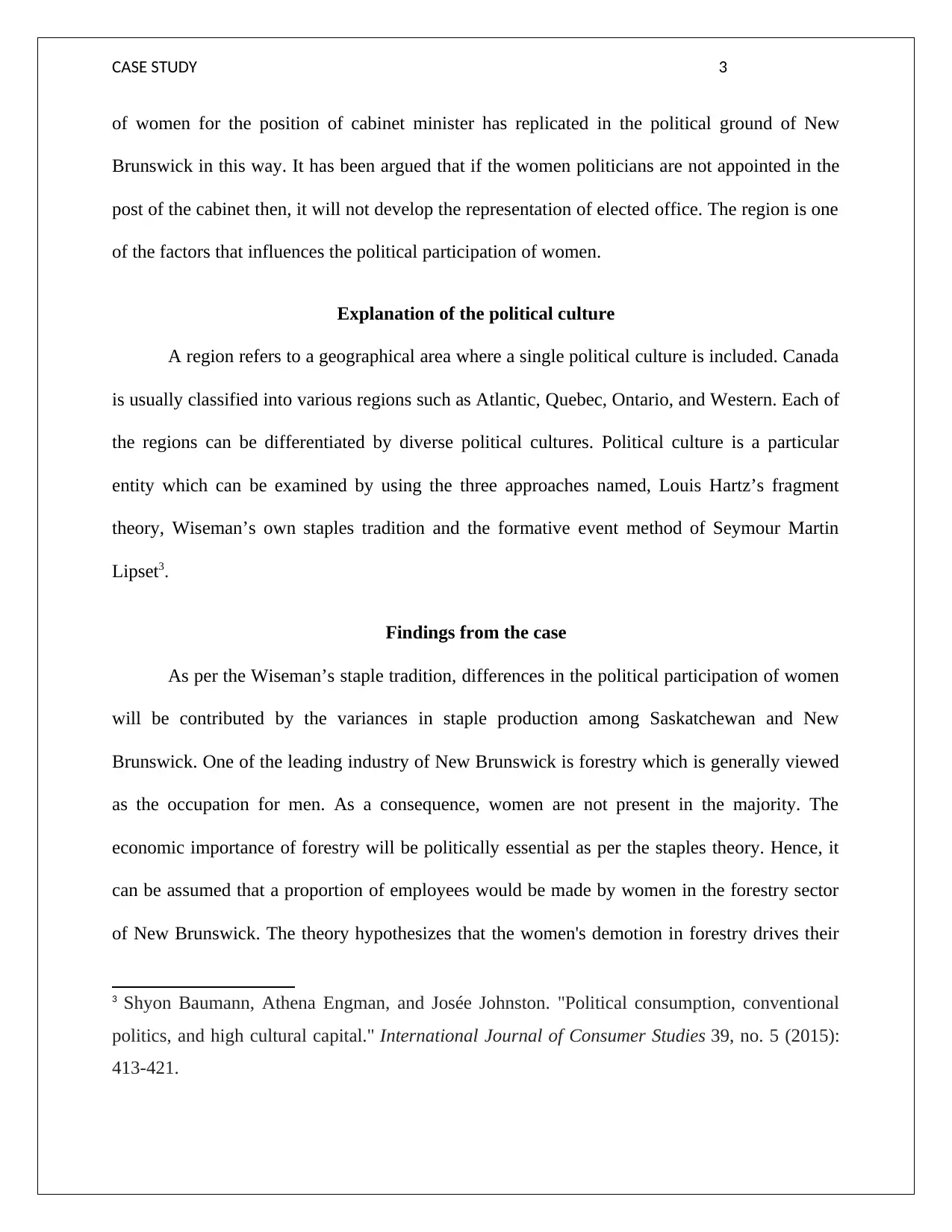
CASE STUDY 3
of women for the position of cabinet minister has replicated in the political ground of New
Brunswick in this way. It has been argued that if the women politicians are not appointed in the
post of the cabinet then, it will not develop the representation of elected office. The region is one
of the factors that influences the political participation of women.
Explanation of the political culture
A region refers to a geographical area where a single political culture is included. Canada
is usually classified into various regions such as Atlantic, Quebec, Ontario, and Western. Each of
the regions can be differentiated by diverse political cultures. Political culture is a particular
entity which can be examined by using the three approaches named, Louis Hartz’s fragment
theory, Wiseman’s own staples tradition and the formative event method of Seymour Martin
Lipset3.
Findings from the case
As per the Wiseman’s staple tradition, differences in the political participation of women
will be contributed by the variances in staple production among Saskatchewan and New
Brunswick. One of the leading industry of New Brunswick is forestry which is generally viewed
as the occupation for men. As a consequence, women are not present in the majority. The
economic importance of forestry will be politically essential as per the staples theory. Hence, it
can be assumed that a proportion of employees would be made by women in the forestry sector
of New Brunswick. The theory hypothesizes that the women's demotion in forestry drives their
3 Shyon Baumann, Athena Engman, and Josée Johnston. "Political consumption, conventional
politics, and high cultural capital." International Journal of Consumer Studies 39, no. 5 (2015):
413-421.
of women for the position of cabinet minister has replicated in the political ground of New
Brunswick in this way. It has been argued that if the women politicians are not appointed in the
post of the cabinet then, it will not develop the representation of elected office. The region is one
of the factors that influences the political participation of women.
Explanation of the political culture
A region refers to a geographical area where a single political culture is included. Canada
is usually classified into various regions such as Atlantic, Quebec, Ontario, and Western. Each of
the regions can be differentiated by diverse political cultures. Political culture is a particular
entity which can be examined by using the three approaches named, Louis Hartz’s fragment
theory, Wiseman’s own staples tradition and the formative event method of Seymour Martin
Lipset3.
Findings from the case
As per the Wiseman’s staple tradition, differences in the political participation of women
will be contributed by the variances in staple production among Saskatchewan and New
Brunswick. One of the leading industry of New Brunswick is forestry which is generally viewed
as the occupation for men. As a consequence, women are not present in the majority. The
economic importance of forestry will be politically essential as per the staples theory. Hence, it
can be assumed that a proportion of employees would be made by women in the forestry sector
of New Brunswick. The theory hypothesizes that the women's demotion in forestry drives their
3 Shyon Baumann, Athena Engman, and Josée Johnston. "Political consumption, conventional
politics, and high cultural capital." International Journal of Consumer Studies 39, no. 5 (2015):
413-421.
You're viewing a preview
Unlock full access by subscribing today!
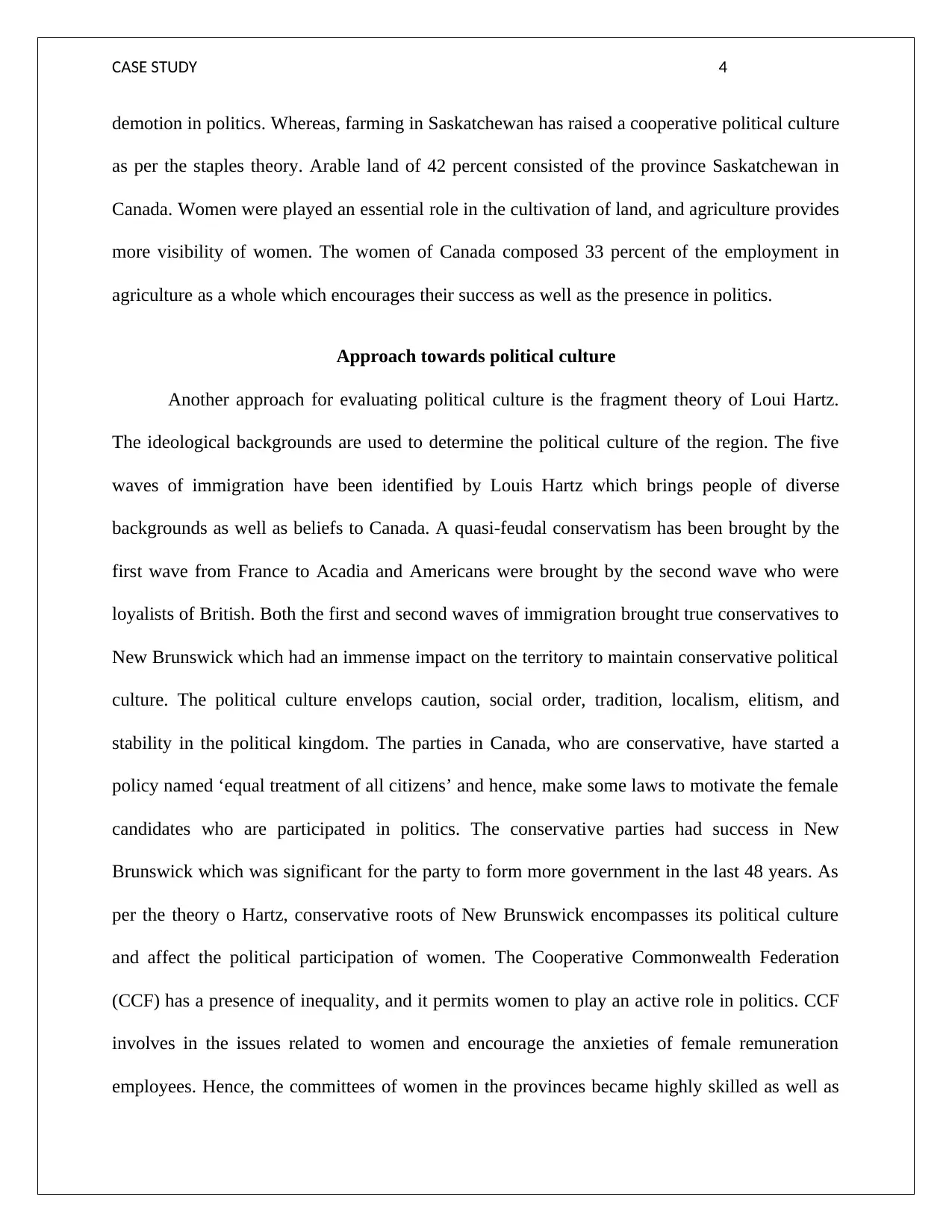
CASE STUDY 4
demotion in politics. Whereas, farming in Saskatchewan has raised a cooperative political culture
as per the staples theory. Arable land of 42 percent consisted of the province Saskatchewan in
Canada. Women were played an essential role in the cultivation of land, and agriculture provides
more visibility of women. The women of Canada composed 33 percent of the employment in
agriculture as a whole which encourages their success as well as the presence in politics.
Approach towards political culture
Another approach for evaluating political culture is the fragment theory of Loui Hartz.
The ideological backgrounds are used to determine the political culture of the region. The five
waves of immigration have been identified by Louis Hartz which brings people of diverse
backgrounds as well as beliefs to Canada. A quasi-feudal conservatism has been brought by the
first wave from France to Acadia and Americans were brought by the second wave who were
loyalists of British. Both the first and second waves of immigration brought true conservatives to
New Brunswick which had an immense impact on the territory to maintain conservative political
culture. The political culture envelops caution, social order, tradition, localism, elitism, and
stability in the political kingdom. The parties in Canada, who are conservative, have started a
policy named ‘equal treatment of all citizens’ and hence, make some laws to motivate the female
candidates who are participated in politics. The conservative parties had success in New
Brunswick which was significant for the party to form more government in the last 48 years. As
per the theory o Hartz, conservative roots of New Brunswick encompasses its political culture
and affect the political participation of women. The Cooperative Commonwealth Federation
(CCF) has a presence of inequality, and it permits women to play an active role in politics. CCF
involves in the issues related to women and encourage the anxieties of female remuneration
employees. Hence, the committees of women in the provinces became highly skilled as well as
demotion in politics. Whereas, farming in Saskatchewan has raised a cooperative political culture
as per the staples theory. Arable land of 42 percent consisted of the province Saskatchewan in
Canada. Women were played an essential role in the cultivation of land, and agriculture provides
more visibility of women. The women of Canada composed 33 percent of the employment in
agriculture as a whole which encourages their success as well as the presence in politics.
Approach towards political culture
Another approach for evaluating political culture is the fragment theory of Loui Hartz.
The ideological backgrounds are used to determine the political culture of the region. The five
waves of immigration have been identified by Louis Hartz which brings people of diverse
backgrounds as well as beliefs to Canada. A quasi-feudal conservatism has been brought by the
first wave from France to Acadia and Americans were brought by the second wave who were
loyalists of British. Both the first and second waves of immigration brought true conservatives to
New Brunswick which had an immense impact on the territory to maintain conservative political
culture. The political culture envelops caution, social order, tradition, localism, elitism, and
stability in the political kingdom. The parties in Canada, who are conservative, have started a
policy named ‘equal treatment of all citizens’ and hence, make some laws to motivate the female
candidates who are participated in politics. The conservative parties had success in New
Brunswick which was significant for the party to form more government in the last 48 years. As
per the theory o Hartz, conservative roots of New Brunswick encompasses its political culture
and affect the political participation of women. The Cooperative Commonwealth Federation
(CCF) has a presence of inequality, and it permits women to play an active role in politics. CCF
involves in the issues related to women and encourage the anxieties of female remuneration
employees. Hence, the committees of women in the provinces became highly skilled as well as
Paraphrase This Document
Need a fresh take? Get an instant paraphrase of this document with our AI Paraphraser
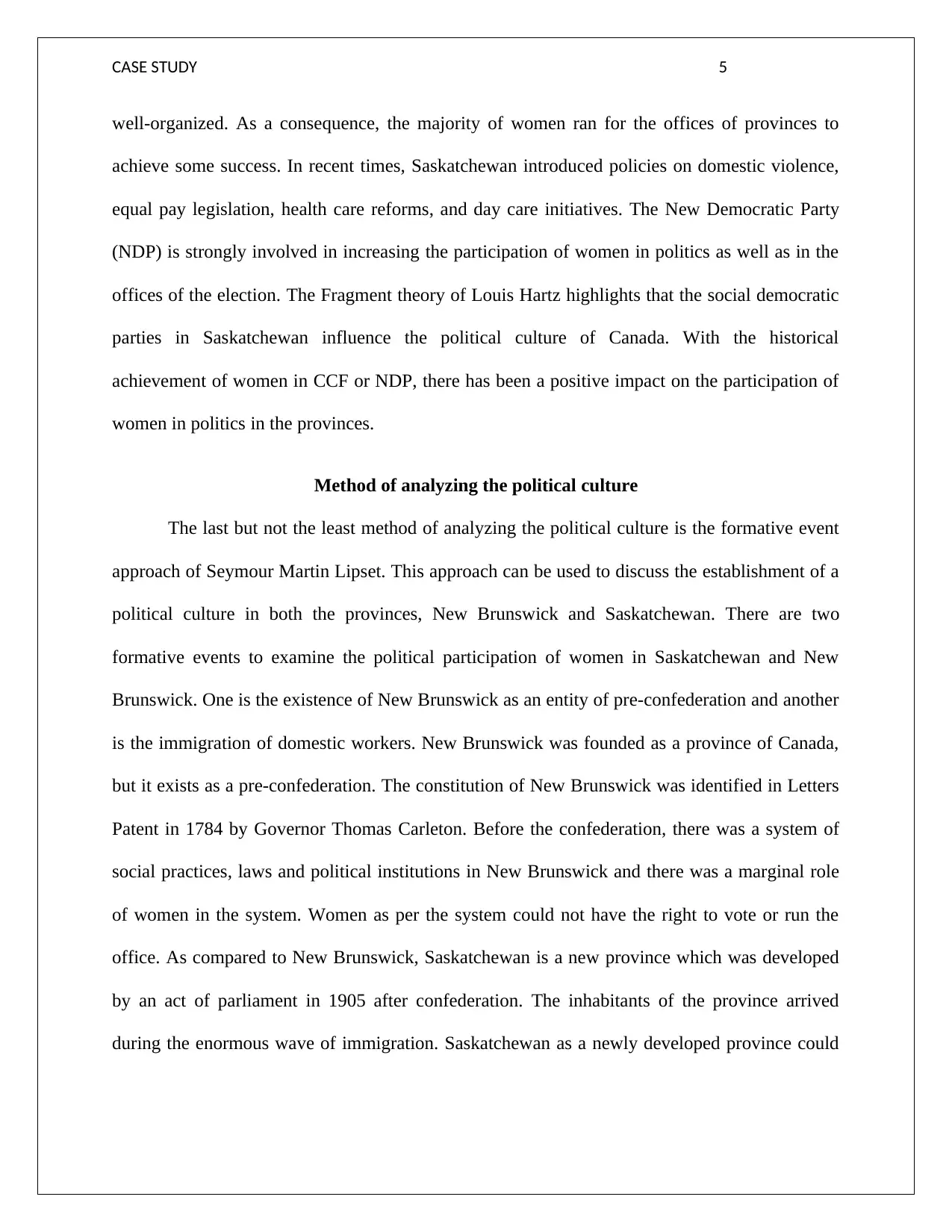
CASE STUDY 5
well-organized. As a consequence, the majority of women ran for the offices of provinces to
achieve some success. In recent times, Saskatchewan introduced policies on domestic violence,
equal pay legislation, health care reforms, and day care initiatives. The New Democratic Party
(NDP) is strongly involved in increasing the participation of women in politics as well as in the
offices of the election. The Fragment theory of Louis Hartz highlights that the social democratic
parties in Saskatchewan influence the political culture of Canada. With the historical
achievement of women in CCF or NDP, there has been a positive impact on the participation of
women in politics in the provinces.
Method of analyzing the political culture
The last but not the least method of analyzing the political culture is the formative event
approach of Seymour Martin Lipset. This approach can be used to discuss the establishment of a
political culture in both the provinces, New Brunswick and Saskatchewan. There are two
formative events to examine the political participation of women in Saskatchewan and New
Brunswick. One is the existence of New Brunswick as an entity of pre-confederation and another
is the immigration of domestic workers. New Brunswick was founded as a province of Canada,
but it exists as a pre-confederation. The constitution of New Brunswick was identified in Letters
Patent in 1784 by Governor Thomas Carleton. Before the confederation, there was a system of
social practices, laws and political institutions in New Brunswick and there was a marginal role
of women in the system. Women as per the system could not have the right to vote or run the
office. As compared to New Brunswick, Saskatchewan is a new province which was developed
by an act of parliament in 1905 after confederation. The inhabitants of the province arrived
during the enormous wave of immigration. Saskatchewan as a newly developed province could
well-organized. As a consequence, the majority of women ran for the offices of provinces to
achieve some success. In recent times, Saskatchewan introduced policies on domestic violence,
equal pay legislation, health care reforms, and day care initiatives. The New Democratic Party
(NDP) is strongly involved in increasing the participation of women in politics as well as in the
offices of the election. The Fragment theory of Louis Hartz highlights that the social democratic
parties in Saskatchewan influence the political culture of Canada. With the historical
achievement of women in CCF or NDP, there has been a positive impact on the participation of
women in politics in the provinces.
Method of analyzing the political culture
The last but not the least method of analyzing the political culture is the formative event
approach of Seymour Martin Lipset. This approach can be used to discuss the establishment of a
political culture in both the provinces, New Brunswick and Saskatchewan. There are two
formative events to examine the political participation of women in Saskatchewan and New
Brunswick. One is the existence of New Brunswick as an entity of pre-confederation and another
is the immigration of domestic workers. New Brunswick was founded as a province of Canada,
but it exists as a pre-confederation. The constitution of New Brunswick was identified in Letters
Patent in 1784 by Governor Thomas Carleton. Before the confederation, there was a system of
social practices, laws and political institutions in New Brunswick and there was a marginal role
of women in the system. Women as per the system could not have the right to vote or run the
office. As compared to New Brunswick, Saskatchewan is a new province which was developed
by an act of parliament in 1905 after confederation. The inhabitants of the province arrived
during the enormous wave of immigration. Saskatchewan as a newly developed province could

CASE STUDY 6
not establish political institutions for women. Furthermore, this province was developed before
giving the franchise to women, and at the same time, issues related to women gained power.
Analysis of the political culture
Immigration of domestic workers is the second formative event to Canada. More than
54,300 domestic workers from Britain, France, and Ireland immigrated to Canada between 1911
and 1921. Amon those workers, 32 percent were employed on Prairies, and 4 percent were in the
Atlantic region of Canada4. The impact of working conditions of domestic workers was
substantial for the political participation of women. Most of the immigrants were different from
many women of Canada as some were unmarried and had independence. Like unmarried
women, married women do get as many rights as men. Unmarried women were legally as well as
financially independent. The women who were immigrated to Canada had emerged a significant
role in the participation of women in politics. According to the theory, women of the upper and
middle class could easily participate in the political meetings as they had more than one servant
for their household tasks and able to carry on the activities of politics. Hence, in the province of
Saskatchewan, women were providing time to continue political activism because there was an
arrival of immigrated domestic workers considerably.
Through the use of several approaches to the political culture named, the formative
events approach, the staples tradition and the fragment theory, the differences in the political
culture of Saskatchewan and New Brunswick had contributed the political differences in the
women’s political participation (Broom, 2016). Women have to overcome the obstacles of
4 Stephanie Paterson, Patrik Marier, and Felix Chu. "Technocracy or transformation? Mapping
women's policy agencies and orienting gender (in) equality in the Canadian
provinces." Canadian Public Administration 59, no. 3 (2016): 405-424.
not establish political institutions for women. Furthermore, this province was developed before
giving the franchise to women, and at the same time, issues related to women gained power.
Analysis of the political culture
Immigration of domestic workers is the second formative event to Canada. More than
54,300 domestic workers from Britain, France, and Ireland immigrated to Canada between 1911
and 1921. Amon those workers, 32 percent were employed on Prairies, and 4 percent were in the
Atlantic region of Canada4. The impact of working conditions of domestic workers was
substantial for the political participation of women. Most of the immigrants were different from
many women of Canada as some were unmarried and had independence. Like unmarried
women, married women do get as many rights as men. Unmarried women were legally as well as
financially independent. The women who were immigrated to Canada had emerged a significant
role in the participation of women in politics. According to the theory, women of the upper and
middle class could easily participate in the political meetings as they had more than one servant
for their household tasks and able to carry on the activities of politics. Hence, in the province of
Saskatchewan, women were providing time to continue political activism because there was an
arrival of immigrated domestic workers considerably.
Through the use of several approaches to the political culture named, the formative
events approach, the staples tradition and the fragment theory, the differences in the political
culture of Saskatchewan and New Brunswick had contributed the political differences in the
women’s political participation (Broom, 2016). Women have to overcome the obstacles of
4 Stephanie Paterson, Patrik Marier, and Felix Chu. "Technocracy or transformation? Mapping
women's policy agencies and orienting gender (in) equality in the Canadian
provinces." Canadian Public Administration 59, no. 3 (2016): 405-424.
You're viewing a preview
Unlock full access by subscribing today!
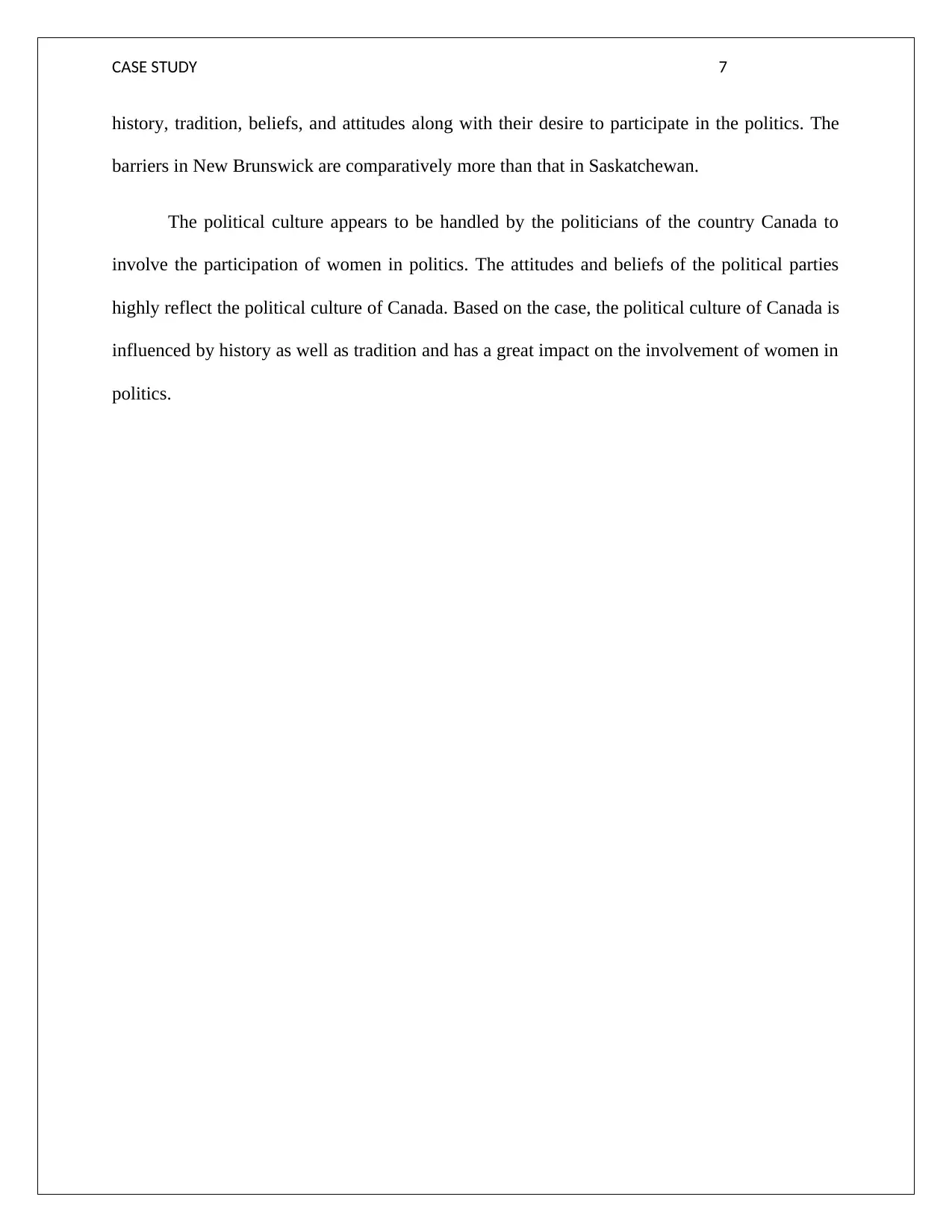
CASE STUDY 7
history, tradition, beliefs, and attitudes along with their desire to participate in the politics. The
barriers in New Brunswick are comparatively more than that in Saskatchewan.
The political culture appears to be handled by the politicians of the country Canada to
involve the participation of women in politics. The attitudes and beliefs of the political parties
highly reflect the political culture of Canada. Based on the case, the political culture of Canada is
influenced by history as well as tradition and has a great impact on the involvement of women in
politics.
history, tradition, beliefs, and attitudes along with their desire to participate in the politics. The
barriers in New Brunswick are comparatively more than that in Saskatchewan.
The political culture appears to be handled by the politicians of the country Canada to
involve the participation of women in politics. The attitudes and beliefs of the political parties
highly reflect the political culture of Canada. Based on the case, the political culture of Canada is
influenced by history as well as tradition and has a great impact on the involvement of women in
politics.
Paraphrase This Document
Need a fresh take? Get an instant paraphrase of this document with our AI Paraphraser
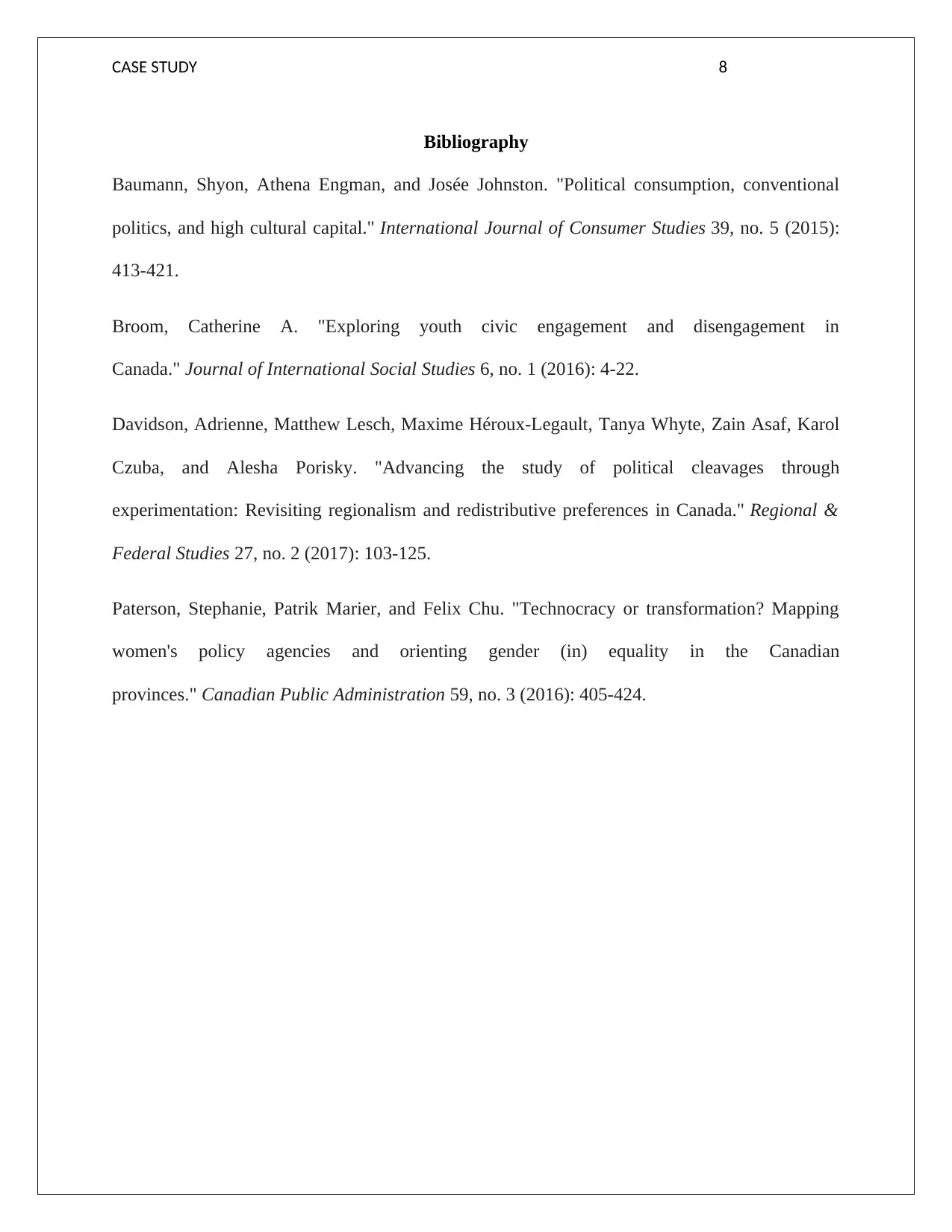
CASE STUDY 8
Bibliography
Baumann, Shyon, Athena Engman, and Josée Johnston. "Political consumption, conventional
politics, and high cultural capital." International Journal of Consumer Studies 39, no. 5 (2015):
413-421.
Broom, Catherine A. "Exploring youth civic engagement and disengagement in
Canada." Journal of International Social Studies 6, no. 1 (2016): 4-22.
Davidson, Adrienne, Matthew Lesch, Maxime Héroux-Legault, Tanya Whyte, Zain Asaf, Karol
Czuba, and Alesha Porisky. "Advancing the study of political cleavages through
experimentation: Revisiting regionalism and redistributive preferences in Canada." Regional &
Federal Studies 27, no. 2 (2017): 103-125.
Paterson, Stephanie, Patrik Marier, and Felix Chu. "Technocracy or transformation? Mapping
women's policy agencies and orienting gender (in) equality in the Canadian
provinces." Canadian Public Administration 59, no. 3 (2016): 405-424.
Bibliography
Baumann, Shyon, Athena Engman, and Josée Johnston. "Political consumption, conventional
politics, and high cultural capital." International Journal of Consumer Studies 39, no. 5 (2015):
413-421.
Broom, Catherine A. "Exploring youth civic engagement and disengagement in
Canada." Journal of International Social Studies 6, no. 1 (2016): 4-22.
Davidson, Adrienne, Matthew Lesch, Maxime Héroux-Legault, Tanya Whyte, Zain Asaf, Karol
Czuba, and Alesha Porisky. "Advancing the study of political cleavages through
experimentation: Revisiting regionalism and redistributive preferences in Canada." Regional &
Federal Studies 27, no. 2 (2017): 103-125.
Paterson, Stephanie, Patrik Marier, and Felix Chu. "Technocracy or transformation? Mapping
women's policy agencies and orienting gender (in) equality in the Canadian
provinces." Canadian Public Administration 59, no. 3 (2016): 405-424.
1 out of 8
Your All-in-One AI-Powered Toolkit for Academic Success.
+13062052269
info@desklib.com
Available 24*7 on WhatsApp / Email
![[object Object]](/_next/static/media/star-bottom.7253800d.svg)
Unlock your academic potential
© 2024 | Zucol Services PVT LTD | All rights reserved.
